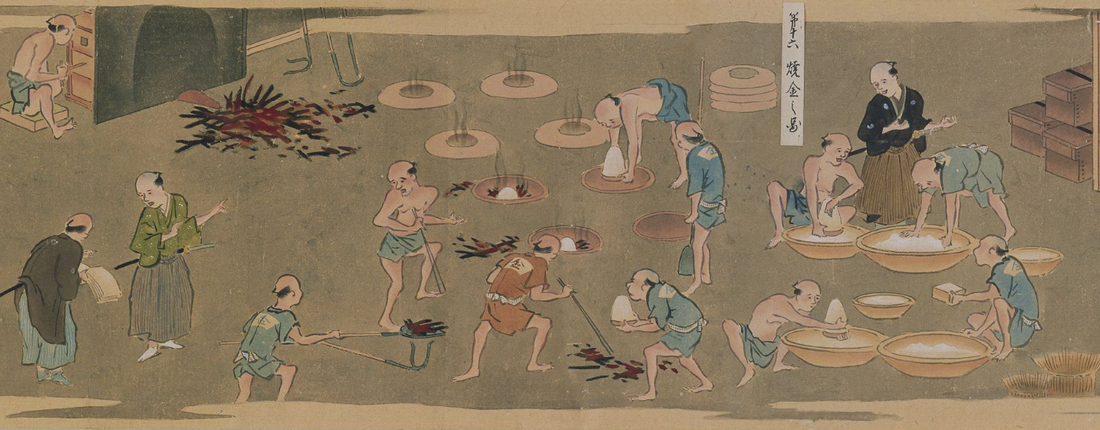Making Material

Step 1: Sourced lower-purity gold, which contained unwanted base metals, was mixed with a salt and melted in earthenware bowls in the floor. This process took many hours and separated the dross (such as copper and lead) from the source gold. The gold was now of very high purity.
Creating precise gold/silver alloy long bars to make Kobans

Step 2: Pure gold and silver bars of high purity were melted together to create the exact alloy needed to make Kobans. The resulting alloy was poured into molds making long bars.

Step 3: The long bars were heated in a kiln making them soft and easily hammered thin.

Step 4: The thin bars were cut into pieces with a weight of 1 Ryo Koban.

Step 5: The thin bars were cut into pieces with a weight of 1 Ryo Koban.

Step 6: Mint Master inspection of Kobans. The mint master hammers their stamp on the reverse.

Step 7: The horizontal lines are hammered into the obverse of a koban. These lines hammered into a koban show the inside is the same solid gold throughout.

Step 8: The Gotō family officers hammer the Paulownia seals, the denomination stamp 1 Ryō, the Mitsutsugu seal, the Gotō family seal, and finally the era seal (different for each era minted).
Final appearance finishing process
Kobans were treated with a chemical which made the surface a bright gold color eliminating any silver color that might be showing from the gold/silver alloy. The silver color was more of a problem in the 1800's as the silver content of Kobans rose to over 40%! Lastly, the Kobans were polished with a mix of river sand and coarse salt . While this smoothed any rough surfaces, it resulted in a number of hairline scratches which are normal on Kobans.
"Iroage" - The key process to making Koban Beautiful!
The process of treating Kobans with a chemical was called "Iroage ( 色増 )" . This technique removed silver from the surface layer to make Kobans look more like pure gold. The chemical process was done on Koban when the gold purity dropped below 75% or even lower in Genroku, Genbun, Bunsei, Tempō, Ansei, and Manen eras. Next there was a polishing process with river sand and coarse salt that smoothed the surfaces. All Koban minted in Genroku and after the Genbun era have hairline scratches on the surface from official mint polishing and not from handling or damage after minting.

*"Kanefukikata-no-zu (Drawing of how to blow gold)"
This process was captured in illustrations drawn in 1826


